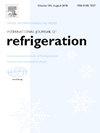Ammonia two-phase flow through the horizontal and inclined impacting T-junctions
IF 3.5
2区 工程技术
Q1 ENGINEERING, MECHANICAL
International Journal of Refrigeration-revue Internationale Du Froid
Pub Date : 2025-04-02
DOI:10.1016/j.ijrefrig.2025.04.001
引用次数: 0
Abstract
The two-phase ammonia flow through the horizontal and inclined impacting T-junctions has been experimentally studied. The phase separation has been investigated in the ID 4, 6 and 10 mm T-junctions at different saturation temperatures (30 to 65 °C), vapour qualities (0.1 to 0.7) and mass fluxes (50 to 300 kg·m-2s-1). Two separation patterns in the horizontal impacting T-junctions were observed. The first one, vapour momentum-independent, shows weak sensitivity of the phase separation behaviour on the pressure, inlet vapour quality and mass velocity. The second one, vapour momentum-dependent, is characterised by the region with the equal phase distribution between the T-junction outlets. The transition between the phase separation patterns does not depend on the inlet two-phase flow pattern. A straightforward phenomenological model was proposed for the separation pattern identification and the evaluation of the vapour quality in the outlet branch of the horizontal impacting T-junctions with a feasible accuracy of ±20 %. Downward orientation (-45°, -90°) of the T-junction inlet leads to a higher phase maldistribution between the outlets than the upward and horizontal configuration. The effect degrades with the mass velocity increase and diameter reduction. The inclination of the T-junction outlets regarding the horizontal plane enhances the phase separation, with the vapour-rich mixture going to the top outlet. The effect intensifies with the increase in the inclination angle and the decrease in the T-junction mass flow rate ratio.
氨两相流通过水平和倾斜冲击t型结
实验研究了两相氨通过水平和倾斜冲击t型结的流动。在不同的饱和温度(30 ~ 65℃)、蒸汽质量(0.1 ~ 0.7)和质量通量(50 ~ 300 kg·m-2s-1)下,研究了id4、6和10 mm t结的相分离。在水平冲击t型接头中观察到两种分离模式。第一种方法与蒸汽动量无关,其相分离行为对压力、进口蒸汽质量和质量速度的敏感性较弱。第二个,蒸汽动量依赖,其特征是在t型结出口之间具有等相位分布的区域。两相分离流型之间的过渡并不取决于进口两相流型。提出了一种直观的现象学模型,用于判别水平冲击t型结出口分支的分离模式和评价蒸汽质量,可行精度为±20%。t型结入口的向下方向(-45°,-90°)导致出口之间的相位不均匀比向上和水平配置更高。随着质量速度的增大和直径的减小,这种效应逐渐减弱。t型结出口相对于水平面的倾斜度增强了相分离,富汽混合物流向顶部出口。这种效应随着倾角的增大和t型结质量流量比的减小而增强。
本文章由计算机程序翻译,如有差异,请以英文原文为准。
求助全文
约1分钟内获得全文
求助全文
来源期刊
CiteScore
7.30
自引率
12.80%
发文量
363
审稿时长
3.7 months
期刊介绍:
The International Journal of Refrigeration is published for the International Institute of Refrigeration (IIR) by Elsevier. It is essential reading for all those wishing to keep abreast of research and industrial news in refrigeration, air conditioning and associated fields. This is particularly important in these times of rapid introduction of alternative refrigerants and the emergence of new technology. The journal has published special issues on alternative refrigerants and novel topics in the field of boiling, condensation, heat pumps, food refrigeration, carbon dioxide, ammonia, hydrocarbons, magnetic refrigeration at room temperature, sorptive cooling, phase change materials and slurries, ejector technology, compressors, and solar cooling.
As well as original research papers the International Journal of Refrigeration also includes review articles, papers presented at IIR conferences, short reports and letters describing preliminary results and experimental details, and letters to the Editor on recent areas of discussion and controversy. Other features include forthcoming events, conference reports and book reviews.
Papers are published in either English or French with the IIR news section in both languages.

 求助内容:
求助内容: 应助结果提醒方式:
应助结果提醒方式:


